1. INTRODUCTION
Taxonomy is considered a key feature in naming, describing, and classifying the organisms, and according to taxonomic studies, the phylum Arthropods is considered the most successful animal group, which contains more than two-thirds of all animal species present on earth. Class Insecta comprises about 90% of tropical forest biomass [16]. Insects are the largest faunal group in the biodiversity of any area, and due to this, the taxonomic study of the insect group is very important for scientific reasons and insect conservation programs. The order Lepidoptera is considered to be the most diverse and second largest in the class Insecta [9]. The moths (Lepidoptera) are constituted to sub-order heterocera of the order Lepidoptera that have very significant roles in the forest and other ecosystems [56]. Only very little information is available on the moth (Lepidoptera) because of the preference of researchers to work on less diverse taxa [51].
1.1. Status of the Taxon
Moths are an integral part of most of the ecosystem [57], so their taxonomic studies are very important because they are also being monitored to indicate climatic changes and environmental degradation. Thus, like other animals, moths are now studied as living ecological components. Most of the species of moths consume plant material, both living and decaying, in all manner of ways-(stem borer), eating inside the stem, eating flowers, fruit, roots, bark, and leaves [17,48,40,54]. Some of the species are known to feed on forms of keratin, such as animal fur [49,18], and a few species are parasitic or predatory [39,41]. This ability to utilize a wide variety of food sources has allowed moths to survive in every habitat on Earth [40].
1.2. Global Status
Lepidoptera is the second-largest order of the class Insecta and the most fascinating group. Lepidopterists worldwide work tirelessly to determine the overall diversity of the order Lepidoptera worldwide. Based on their efforts, they have determined that the diversity of the Lepidoptera (Moths and Butterfly) is comprised of 1,57,424 species, 15,578 genera, 139 families, and 4 suborders [44]. Of these species, 88% are moths, which is approximately 1,27,000 moths, and about 15,000 are considered to be butterflies [1]. The total number of identified species of Lepidoptera in the world makes up about 10% of the total animal kingdom and is roughly equivalent to the number of species of flowering plants [57].
1.3. Indian Status
India is among the top 17 mega-biodiversity countries in the world. It ranks 9th in terms of the richness of higher plant species and has around 7–8% of the total biodiversity of the world [45]. The Lepidoptera fauna in India has been estimated to be about 15,000 species, and 84 families fall under this order [10]. Most of them are moths; around 1,501 species are considered to be butterflies [55], and about 12,000 species are moths [12]. The sampling site is Kullu and Mandi districts of Himachal Pradesh, which are part of the Indian Himalayan Region. The diversity of the order Lepidoptera in the Indian Himalayan region is considered to be about 5,356 species, which makes about 36% of the total population of Lepidoptera in India [11], most of which are moths, and their number is estimated to be around 4,107 species [52]. 1,013 species are considered to be butterflies [14]. The diversity of Lepidoptera in Himachal Pradesh is considered to be 1297 species of moths, which belong to 753 genera of 107 subfamilies under 48 families of 19 superfamilies belonging to 05 clades under 02 infraorders. The Geometridae is considered to be the most dominant family in Himachal Pradesh, which includes about 275 species (the fauna of Himachal Pradesh). There are still many moths that have yet to be described by scientists. So, for this, we are making an attempt to make a complete checklist of the moths of Himachal Pradesh by performing an extensive survey and collecting, preserving, and identifying the moth samples.
1.4. Role of Taxonomy in the Conservation of Moths
In the process of protecting moths, it is very important to precisely differentiate the species from one another. Threatened species and endangered species can only be identified and listed if they are properly notable from other similar species. By having complete knowledge of the contribution of moths to the environment and their role in the ecosystem, such as nutrient cycle, pollination, the food chain, and regulation of plants and leaf litter [59]. The flowers that bloom at night do their pollination with the help of bats or moths, and the manmade lighting in our houses attracts the moths toward themselves and takes the moth away from the flowers, which results in no pollination in the night-blooming flowers. The taxonomy study of the moth is very important so that a specifically agreed-upon name can be given to each moth. The specific name is very important; without the specific name, no information can be accrued or exchanged for moths.
The occurrence and population of any living organism have been significantly influenced by the environment that contains biotic and abiotic factors, i.e., the alignment of flora and fauna is determined by climatic conditions [7]. Moth species richness in India is associated with high rainfall, which has enormous diversity, while low rainfall and dry areas moderately have low diversity with fewer species numbers [53]. According to Bell and Scott [8], the richness of individuals is very variable. Individuals of some species are common, while others are rare. A usually uncommon species may seem in great numbers in certain seasons or may be locally abundant in a part of its range. The main objective of the research work is to determine the diversity of moth (Lepidoptera) species in Himachal Pradesh through extensive survey and taxonomic studies, and also to document and prepare a taxonomic inventory of the moth (Lepidoptera) fauna of Himachal Pradesh.
1.5. Taxonomic Terminology and Key Characters of Moths
The taxonomic terminology and key characteristics of the adult moth are similar in many aspects to those of a butterfly. The lepidoptera, in common with all other insects, have the soft parts of the body held inside a hard exoskeleton made up of a substance known as chitin. The integument is soft, delicate, fragile, or hard and parchment-like. Depending on the body size, moths are divided into two groups: micro-moths and macro-moths. The size of moths differs from species to species, from very small to large, with wings expanding from 5 to 190 mm, bearing in mind that the wing area of certain moths is the largest insect in existence [46]. The body is somewhat elongated and cylindrical, and the wings are flat, narrow, or wide, giving a flattened aspect to the whole body. As moths belong to the class Insecta, the body is divided into three major segments: the head, thorax, and abdomen. The moth body also includes the coxa, trochanter, femur, tibia, tarsus, proboscis, palp, eye, antennae, thorax, head, spiracles, abdomen, and wing bases. Antennae may be simple, filiform, unipectinate, bipectinate, doubly bipectinate, ciliated, setose-ciliate, lamellate, fasciculate, or a combination of all of them. In some species, the arrangement of antennae is substantially different between males and females and shows some sexual dimorphism [5]. At the base of the antennae, a pair of prominent black globular compound eyes are present. Compound eyes may be smooth, hairy, or lashed [5]. The mouthparts comprise proboscis, containing two highly adapted maxillae, held together by a series of hooks and spikes to form a tube through which liquid food may be sucked. Normally, the proboscis is coiled like a watch spring beneath the head. The thorax is well established and divided into three parts: the prothorax, mesothorax, and metathorax. Thorax is segmented, closely fused, and not readily recognizable from each other; the venter is called the pectus [5]. The wings are well established, rarely vestigial; they are membranous and usually enclosed with scales on both dorsal and ventral sides [5]. The wings of the moth have two membranes, the upper and lower membranes, which are connected with the small fibers and supported by the hollow ribs, mentioned as veins. The wings also contain nerve fibers, tracheae, and blood vessels [15,13]. The legs are typically well developed and are in three pairs; each pair is made from the ventral side of the three thoracic segments, respectively. Legs are divided into five segments: coxa, trochanter, femur, tibia, and tarsus. The tarsi are normally five-segment and normally clawed, first longest and swollen. In many species, the legs contain highly specialized sensory or taste organs [3]. The abdomen is divided into ten movable segments. The abdomen carries the organs of digestion, respiration, and excretion, and in females, the gonads produce the eggs. A tympanum may be present on the sides of the segment near the first pair of abdominal spiracles. In geometroidea, the tympanum is closely associated with the first abdominal spiracle. Spiracles are found on the sides of segments 1–7 of the abdomen [3].
2. MATERIALS AND METHODS
2.1. Study Area
The current research work was done from August 2020 to October 2020 and June 2021 to October 2021. The nine sampling sites were selected based on the difference in their altitude, starting from 750m to 2,000 m above the main sea level. Out of which 4 belong to Mandi (Sadar Mandi, Joginder Nagar, Sarkaghat, and Sunder Nagar) and 5 belong to Kullu (Banjar, Tandi, Chethar, Bini, and Bahu) for the collection of the samples of moth. Kullu and Mandi districts lie in the Northwestern hilly state of India and are also part of the Western Himalayan region. It is one of India’s eleven mountainous states and covers around 55,673 sq. km, or roughly 5.8% of the country’s total land area. Himachal Pradesh is located at latitude 30°22’N and longitude 75°02’E. 5.57 million hectares of land are covered by a height range of 460–6,600 m.
Kullu District is located at 31.9592°N and 77.1089°E. It is situated alongside the Beas River. The settlement is 1,278 m (4,193 feet) above sea level. 5,503 sq. km is the size of Kullu. It is bounded on the north and east by Lahaul and Spiti, on the southeast by Kinnaur, on the south by Shimla, on the southeast and west by Mandi, and the northwest by Kangra. Generally, the climate of Kullu is cold and dry, and the year is divided into three major seasons. Summer (April-July), rainy (August-September), and winter (October–March) from December to February. The period is very chilly, and there is heavy frost and snowfall in the region. The average rainfall in Kullu district is 800 mm, the maximum temperature is 38°C, and the minimum temperature is 3°C. The valley has varied biodiversity and consists of the rarest animals such as the Himalayan thar, Western tragopan, monal, Himalayan brown bear, and snow leopard. Kullu also has a Great Himalayan National Park located near Banjar (one of our sampling sites) to protect the flora and fauna of the area. The 5 sampling sites in Kullu (Banjar, Tandi, Chethar, Bini, and Bahu) were identified based on their different altitudes, and moth samples were collected.
Mandi is located at 31.7087°N, 76.9320°E, on the left bank of the Beas River, near the base of the Shivalik mountain ranges. Mandi is located at a height of 760 m (2,495 feet) above sea level. The overall area is 3950 sq. km. It is bordered on the north by Choota Banagahal and on the east by the Nargu range, which divides it from the Kullu Valley. On the South, it adjoins Suket, and on the west, Hamirpur and Bilaspur districts. The mandi climate is classified as warm and temperate. The temperature in Mandi in summer ranges between 18 and 39°C and between 6–26°C in winter. The average rainfall in Mandi is about 1311.50 mm. The biodiversity of Mandi consists of common palm civets, Indian hares, barking deer, etc. The 4 sampling sites (Sadar Mandi, Joginder Nagar, Sarkaghat, and Sunder Nagar) were identified based on their different altitudes, and the moth samples were collected. The coordinates and altitude of all the nine sampling sites are mentioned in Table 1, and along with this, the maps of the sampling sites are also shown below.
Table 1: Study area along with their GPS coordinates and altitude.
| Study site | GPS coordinates | Altitude (m) |
|---|---|---|
| Mandi | ||
| Sadar Mandi | 31.7079° N, 76.9359° E | 764 |
| Joginder Nagar | 31.9912° N, 76.7899° E | 800 |
| Sarkaghat | 31.6990° N, 76.7324° E | 996 |
| Sunder Nagar | 31.5299° N, 76.8889° E | 1,174 |
| Kullu | ||
| Banjar | 31.6377° N, 77.3441° E | 1,356 |
| Tandi | 31.5802° N, 77.3525° E | 1,500 |
| Chethar | 31.6495° N, 77.3023° E | 1,674 |
| Bini | 31.6074° N, 77.3726° E | 1,800 |
| Bahu | 31.6148° N, 77.3273° E | 2,065 |
2.2. Collection Method
The collection of moths was done at night from 7 p.m. to 5 a.m. using a light trap method. We spread a screen of white cloth (12” × 6”) between two vertical poles and illuminated by white light emitting from fluorescent or CFL lamps. Many commercially available trap designs are not suitable for tropical conditions due to their small size, which cannot accommodate enormous catches [2]. The moth samples were first collected from the 9 different sites and were then sacrificed with the help of a killing jar. The chemical ethyl acetate (C4H8O2) was used to sacrifice the moth by filling the killing jar with a few drops of ethyl acetate, a standard process used by the Lepidopterolpgy. The pinning of the moth was done through an entomological pin commonly known as insect pin, which was inserted into the center of the thorax and perpendicular to the body of the insect. We complete the insertion by placing the top of the specimen ¼ inch from the top of the pin. The mounting of the moth specimen was done through the insect stretching board or thick thermocol sheet. The size of the gap in the insect stretching board depends on the size of the abdomen of the specimen. Place the pinned specimen on the insect stretching board or thick thermocol sheet, with the wings touching the board. For setting the specimen, butter paper or spreading strips were used on either side of the wings and fixed by stainless-steel paper pins. When both sides of the wings were set, the abdomen was checked to see whether it was in a horizontal or an angled position. Antennae were also set in such a way that they would not collapse with each other. After setting, the specimens were set to be dried. The average time for drying the specimens was 3–4 days. These are both laborious and time-consuming procedures, as noted by many lepidopterists [16]. The entomological box was fumigated to do the dry preservation of moths. The collected specimen was then morphologically identified up to the species level with the help of the standard taxonomic key and different websites.
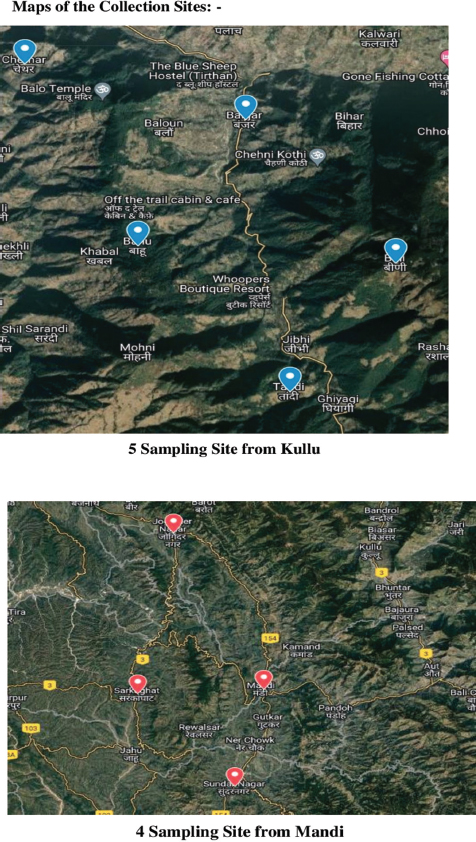 |
2.2.1. Genitalia dissection
The genitalia dissection of the moth’s sample was performed by cutting the abdomen of the stretched sample, which was then boiled in a 10% KOH solution for 10 min. The surrounding tissue was then cleaned, and the remaining parts were dehydrated with ethanol, and then the genitalia were mounted on a microscope slide. The genitalia were then photographed and processed [50].
2.3. Identification of Moth Samples
The identification of the moths was done with proper literature, which includes the Marcellous moths of Nepal [2], an introduction to the moth species of southeast Asia [5], the fauna of British India [8,20,21,22], and assemblages of Lepidoptera in Indian Himalaya [11]. Hampson G. 1892, 1894 & 1895, [20-22] Moths of Nepal, [23-28]. Micro moth of south-east Asia [47].The moths of Borneo [30-36], the moths of Thailand [37], the list of the lepidoptera collected by the Rev. J.H. Hocking chiefly in the Kangra District [42], and the micromoth of southeast Asia [49]. Web resources dedicated to lepidopteran diversity were also utilized to confirm or check the species names. The classification followed here is given by Nieukerken 2011 [43], and the moth samples were also identified by comparing the specimen with the specimen available at Zoological Survey of India (ZSI). Solan and a few specimens are also identified through photographs that have been previously identified by lepidopterists.
3. RESULTS
The current research work was done to estimate the biodiversity of the moths (lepidoptera) from Kullu and Mandi Districts of Himachal Pradesh. The moth sample was collected between August 2020 and October 2020 and between June 2021 and October 2021. The nine sampling sites were selected based on the difference in their altitude, starting from 750 m to 2,000 m above the main sea level. Out of which 4 belong to Mandi (Sadar Mandi, Joginder Nagar, Sarkaghat, and Sunder Nagar) and 5 belong to Kullu (Banjar, Tandi, Chethar, Bini, and Bahu) for the collection of the samples of moth. The final result of the research work was the collection of a total of 300 samples (230 from Kullu and 70 from Mandi) of moths belonging to 82 species, 67 genera, 20 subfamilies, and 14 families (Bombycidae, Cossidae, Crambidae, Drepanidae, Endromidae, Erebidae, Eupterotidae, Geometridae, Lasiocampidae, Noctuidae, Nolidae, Notodontidae, Saturniidae, and Sphingidae) were collected, preserved, and identified as shown in Table 3.
Table 2: The list of all identified moths with their family, subfamily, scientific names, gender and their total number.
| S. No | Family | Subfamily | Scientific Name and Author | No. of samples collected from Kullu | No. of samples collected from Mandi | Total samples collected | ||
|---|---|---|---|---|---|---|---|---|
| 1 | Bombycidae | Bombycinae | Bombyx huttoni (Westwood, 1847) | 5 ♂ | 2♀ | 2♂ | 2♀ | 11 |
| 2 | Bombycidae | Bombycinae | Bombyx mandrina (Moore, 1872) | 1 ♂ | 1 | |||
| 3 | Cossidea | - | Zeuzera multistrigata (Moore, 1881) | 1 ♂ | 1 | |||
| 4 | Crambidae | - | Pygospila tyres (Cramer, 1780) | 1 ♂ | 1♀ | 1♂ | 3 | |
| 5 | Drepanidae | Drepanidae | Drepana pallida (Moore, 1879) | 1 ♂ | 1 | |||
| 6 | Endromidae | - | Mustilia sphingiformis (Moore, 1879) | 1 ♂ | 1 ♀ | 1♀ | 3 | |
| 7 | Erebidae | Aganainae | Asota caricae (Fabricius, 1775) | 3♂ | 3♀ | 1♂ | 1♀ | 8 |
| 8 | Erebidae | Arctiinae | Aglaomorpha plagiata (Walker, 1855) | 5♂ | 3♀ | 2♀ | 10 | |
| 9 | Erebidae | Arctiinae | Areas galactina intermedia (Rothschild, 1933) | 1♂ | 1 | |||
| 10 | Erebidae | Arctiinae | Areas galactina orientalis (Walker, 1855) | 1♂ | 1 | |||
| 11 | Erebidae | Arctiinae | Barsine Sp. | 4♂ | 8♀ | 2♂ | 2♀ | 16 |
| 12 | Erebidae | Arctiinae | Ceratonotos transiens vacillans (Walker, 1855) | 5♂ | 6♀ | 1♀ | 12 | |
| 13 | Erebidae | Arctiinae | Cernyia arizana (Matsumura, 1927) | 1♂ | 1 | |||
| 14 | Erebidae | Arctiinae | Chrysorabdia bivitta (Walker, 1856) | 4♂ | 4♀ | 1♂ | 9 | |
| 15 | Erebidae | Arctiinae | Cyana adita (Moore, 1859) | 1♀ | 1 | |||
| 16 | Erebidae | Arctiinae | Cyana arorai | 1♂ | 1 | |||
| 17 | Erebidae | Arctiinae | Cyana arama arama (Moore, 1859) | 1♂ | 1 | |||
| 18 | Erebidae | Arctiinae | Cyana arama metis | 4♂ | 3♀ | 1♂ | 8 | |
| 19 | Erebidae | Arctiinae | Cyana bellissima (Moore, 1878) | 1♀ | 1 | |||
| 20 | Erebidae | Arctiinae | Cyana catorhoda (Hampson, 1897) | 1♀ | 1 | |||
| 21 | Erebidae | Arctiinae | Cyana intercomma (?erný, 2009) | 1♂ | 1 | |||
| 22 | Erebidae | Arctiinae | Cyana peregrina (Walker, 1854) | 1♀ | 1 | |||
| 23 | Erebidae | Arctiinae | Eucallimorpha principalis principalis (Kollor, 1844) | 1♂ | 1 | |||
| 24 | Erebidae | Arctiinae | Lemyra boghaika (Tshistjakov and Kishida, 1994) | 1♂ | 1♀ | 1♀ | 3 | |
| 25 | Erebidae | Arctiinae | Lemyra multivittata (Moore, 1865) | 1♂ | 1 | |||
| 26 | Erebidae | Arctiinae | Lemyra wernerthomasi (Inoue, 1993) | 2♂ | 2♀ | 1♂ | 1♀ | 6 |
| 27 | Erebidae | Arctiinae | Lemyra Sp. | 1♂ | 1 | |||
| 28 | Erebidae | Arctiinae | Mangina argus (Kollar, 1847) | 1♂ | 1♀ | 2 | ||
| 29 | Erebidae | Arctiinae | Nyctemera adversata (Schaller, 1788) | 3♂ | 7♀ | 3♂ | 1♀ | 14 |
| 30 | Erebidae | Arctiinae | Spilarctia Sp. | 2♂ | 1♀ | 3 | ||
| 31 | Erebidae | Arctiinae | Spilosoma pellucida (Rothschild, 1910) | 3♂ | 2♀ | 5 | ||
| 32 | Erebidae | Arctiinae | Spilosoma rhodophila (Walker, 1864) | 3♀ | 3 | |||
| 33 | Erebidae | Arctiinae | Spilosoma sagittifera (Moore, 1888) | 2♂ | 8♀ | 1♂ | 11 | |
| 34 | Erebidae | Arctiinae | Spilosoma Sp. | 1♀ | 1 | |||
| 35 | Erebidae | Catocalinae | Catocala palaeogama (Guenne, 1852) | 1♂ | 1 | |||
| 36 | Erebidae | Calpinae | Hamodes propitia (Guerin-Meneville, 1831) | 2♂ | 1♀ | 1♀ | 4 | |
| 37 | Erebidae | Erebinae | Ophiusa tirhaca (Cramer, 1777) | 1♂ | 1♀ | 1♂ | 1♀ | 4 |
| 38 | Erebidae | Erebinae | Spirama helicina (Hubner, 1824) | 1♂ | 1 | |||
| 39 | Erebidae | Erebinae | Spirama retorta (Clerck, 1764) | 3♂ | 3 | |||
| 40 | Erebidae | Herminiinae | Simplicia niphona (Butler, 1878) | 1♂ | 4♀ | 1♂ | 6 | |
| 41 | Erebidae | Lymantriinae | Lymantria concolour concolour (Walker, 1855) | 6♂ | 2♂ | 8 | ||
| 42 | Erebidae | Lymantriinae | Lymantria mathura subpallida (Moore, 1866) | 3♂ | 3♀ | 1♂ | 1♀ | 8 |
| 43 | Erebidae | Scoliopteryginae | Anomis mesogona (Walker, 1857) | 1♂ | 1 | |||
| 44 | Erebidae | - | Artena dotata (Fabricius, 1794) | 2♀ | 2 | |||
| 45 | Erebidae | - | Bastilla amygdalis (Moore, 1885) | 1♂ | 1 | |||
| 46 | Erebidae | - | Ericeia elongate (Prout, 1929) | 1♂ | 1 | |||
| 47 | Erebidae | - | Mocis frugalis (Fabricius, 1775) | 1♂ | 1 | |||
| 48 | Erebidae | - | Bastilla arctotaenia (Gueene, 1852) | 2♂ | 2♀ | 1♀ | 5 | |
| 49 | Erebidae | - | Sypna diversa (Wileman and South 1971) | 1♂ | 1 | |||
| 50 | Erebidae | - | Sypna Sp. | 1♀ | 1 | |||
| 51 | Geometridae | Geometrinae | Herochroma ochreipicta (C.Swinhoe, 1950) | 1♀ | 1 | |||
| 52 | Geometridae | - | Abraxas sylvata (Scopolia, 1763) | 3♂ | 2♀ | 2♂ | 3♀ | 10 |
| 53 | Geometridae | - | Percnia belluaria (Guenee, 1858) | 4♂ | 2♂ | 6 | ||
| 54 | Geometridae | - | Iotaphora admirabilis (Oberthur, 1884) | 1♀ | 1 | |||
| 55 | Geometridae | - | Tanaorhinus reciprocatus confuciaris (Walker, 1861) | 1♀ | 1 | |||
| 56 | Lasiocampidae | - | Lebeda nobilis (Walker, 1855) | 1♂ | 2♀ | 1♂ | 1♀ | 5 |
| 57 | Lasiocampidae | - | Paralebeda plagifera (Walker, 1855) | 2♂ | 2 | |||
| 58 | Lasiocampidae | - | Trabala vishnou guttata (Mastrumura, 1909) | 6♂ | 2♂ | 8 | ||
| 59 | Lasiocampidae | - | Trabala vishnou vishnou (Lefebver, 1827) | 7♀ | 1♀ | 8 | ||
| 60 | Noctuidea | Acronictinae | Cymatophoropsis sinuata (Moore, 1879) | 2♀ | 1♀ | 3 | ||
| 61 | Noctuidea | Noctuinae | Atrovirensis taiwani (Gyulai, Ronkay and Wu, 2013) | 1♂ | 1 | |||
| 62 | Noctuidea | Stictopterinae | Lophoptera squammigera (Guenee, 1852) | 3♀ | 1♀ | 4 | ||
| 63 | Noctuidea | - | Tiracola aureate (Holloway, 1989) | 4♂ | 4 | |||
| 64 | Noctuidea | - | Tiracola grandirena (Herrich-Schaffer, 1868) | 1♀ | 1 | |||
| 65 | Noctuidea | - | Trichosea ludifica (Linnaeus, 1758) | 1♀ | 1♀ | 2 | ||
| 66 | Noctuidea | - | Tiracola pl agiata (Walker, 1857) | 1♂ | 1 | |||
| 67 | Notodontidae | Notodontinae | Cerura liturata (Walker, 1855) | 1♂ | 1 | |||
| 68 | Saturniidae | Saturniinae | Caligula simla (Westwood, 1847) | 1♀ | 1 | |||
| 69 | Saturniidae | - | Actias selene (Hubner, 1807) | 1♂ | 1 | |||
| 70 | Sphingidae | Macroglossinae | Cechetra lineosa (Walker, 1856) | 2♂ | 2 | |||
| 71 | Sphingidae | Macroglossinae | Hippotion Celerio (Linnaeus, 1758) | 1♀ | 1 | |||
| 72 | Sphingidae | Macroglossinae | Nephele hespera (Fabricius, 1775) | 1♂ | 1♀ | 1♂ | 1♀ | 4 |
| 73 | Sphingidae | Macroglossinae | Pergesa acteus (Cramer, 1779) | 1♂ | 1♀ | 2 | ||
| 74 | Sphingidae | Macroglossinae | Rhagastis olivacea (Moore, 1872) | 2♂ | 2 | |||
| 75 | Sphingidae | Macroglossinae | Theretra alecto (Linnaeus, 1758) | 2♂ | 2♀ | 1♂ | 1♀ | 6 |
| 76 | Sphingidae | Macroglossinae | Theretra oldenlandiae (Fabricius, 1775) | 2 ♂ | 2 | |||
| 77 | Sphingidae | Macroglossinae | Theretra Sp. | 4♂ | 2♂ | 6 | ||
| 78 | Sphingidae | Smerinthinae | Ambulyx lahora (Butler, 1875) | 1♀ | 1 | |||
| 79 | Sphingidae | Smerinthinae | Dolbina sp. | 6♂ | 1♂ | 1♀ | 8 | |
| 80 | Erebidae | Calpinae | Eudocima salaminia (Cramer, 1777) | 1♀ | 1 | |||
| 81 | Erebidae | Erebinae | Erebus ephesperis (Hübner, 1827) | 1♀ | 1 | |||
| 82 | Erebidae | Lymantriinae | Himala argentea (Walker, 1855) | 1♀ | 1 | |||
| 83 | Eupterotidae | --- | Apona caschmirensia (Kollar, 1844) | 1♀ | 1 | |||
| 84 | Geometridae | --- | Pseudomiza aurata (Wileman, 1915) | 1♂ | 1 | |||
| 85 | Noctuidea | Amphipyrinae | Amphipyra cupreipennis (Moore, 1882) | 1♀ | 1 | |||
| 86 | Noctuidea | Noctuinae | Xestia semiherbida (Walke, 1857) | 1♂ | 1 | |||
| 87 | Noctuidea | --- | Arcte coerula (Guenee, 1852) | 1♀ | 1 | |||
| 88 | Nolidae | Risobinae | Risoba prominens (Moore, 1881) | 1♀ | 1 | |||
| 89 | Notodontidae | Notodontinae | Pheosia albivertex (Hampson, 1892) | 1♀ | 1 | |||
| 90 | Saturniidae | Samia canningi (Hutton, 1859) | 1♀ | 1 | ||||
| 91 | Sphingidae | Macroglossinae | Acosmeryx anceus subdentata (Rothschild and Jorean, 1903) | 1♂ | 1 | |||
| 92 | Sphingidae | Smerinthinae | Anambulyx elwesi (H. Druce, 1882) | 1 ♂ | 1 | |||
| Total | 127♂ Total 230 | 103♀ | 34♂ Total 70 | 36♀ | 300 | |||
Table 3: The relative species abundance of the 300 Individuals collected which belong to the 14 Family, 20 Subfamily, 67 Genus, and 82 Species.
| S. No | Family | Subfamily | Total No. of Moth Species Collected from Kullu | Total No. of Moth Species Collected from Mandi | No. of Individual Collected |
|---|---|---|---|---|---|
| 1 | Bombycidae | Bombycinae | 2 | 1 | 12 |
| 2 | Cossidea | - | 1 | --- | 1 |
| 3 | Crambidae | - | 1 | 1 | 3 |
| 4 | Drepanidae | Drepanidae | 1 | --- | 1 |
| 5 | Endromidae | - | 1 | 1 | 3 |
| 6 | Erebidae | • Aganainae | 1 | 1 | 8 |
| • Arctiinae | 21 | 9 | 116 | ||
| • Catocalinae | 1 | - -- | 1 | ||
| • Calpinae | 1 | 2 | 5 | ||
| • Erebina | 3 | 2 | 9 | ||
| • Herminiinae | 1 | 1 | 6 | ||
| • Lymantriinae | 2 | 3 | 17 | ||
| • Scoliopteryginae | 1 | - -- | 1 | ||
| • Others (Unknown Sub Family) | 6 | 1 | 12 | ||
| Total (Erebidae) | 37 | 18 | 175 | ||
| 7 | Eupterotidae | --- | 1 | 1 | |
| 8 | Geometridae | • Geometrinae | 1 | --- | 1 |
| • Others (Unknown Sub Family) | 4 | 3 | 19 | ||
| Total (Geometridae) | 5 | 3 | 20 | ||
| 9 | Lasiocampidae | - | 3 | 2 | 23 |
| 10 | Noctuidea | • Acronictinae | 1 | 1 | 3 |
| • Amphipyrinae | - -- | 1 | 1 | ||
| • Noctuinae | 1 | 1 | 2 | ||
| • Stictopterinae | 1 | 1 | 4 | ||
| • Others (Unknown Sub Family) | 4 | 2 | 9 | ||
| Total (Noctuidea) | 7 | 6 | 19 | ||
| 11 | Nolidae | Risobinae | --- | 1 | 1 |
| 12 | Notodontidae | Notodontinae | 1 | 1 | 2 |
| 13 | Saturniidae | • Saturniinae | 1 | --- | 1 |
| • Others (Unknown Sub Family) | 1 | 1 | 2 | ||
| Total (Saturniidae) | 2 | 1 | 3 | ||
| 14 | Sphingidae | • Macroglossinae | 7 | 4 | 26 |
| • Smerinthinae | 1 | 2 | 10 | ||
| Total (Sphingidae (Hawk Moth)) | 8 | 6 | 36 | ||
| Total | 69 | 42 | 300 |
From the Kullu district, we collected 43 species, and from the Mandi district, we collected 13 species. Other than these, 26 species were found to be common in both the Kullu and Mandi districts, making an overall collection of 69 species from the Kullu and 39 species from Mandi [Figure 1]. The greatest number of individuals were collected from the family Erebidae 175 followed by Sphingidae 36, followed by Lasiocampidae 23, followed by Geometridae 20, followed by Noctuidae 19, followed by Bombycidae 12, followed by Crambidae, Endromedia, and Saturniidae 3 individuals from each family. The least number of individuals were collected from Notodontidae 2, followed by Cossidae, Drepinidae, Eupterotidae, and Nolidae 1 individuals from each family [Table 2 and Figure 2].
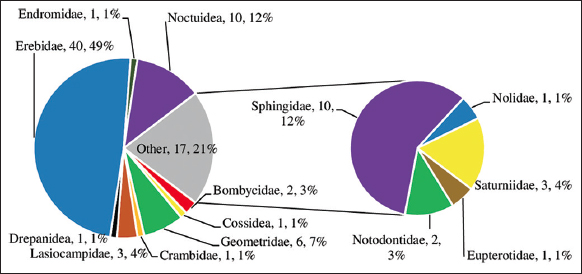 | Figure 1: Representation of total number of species collected from both Mandi and Kullu District of Himachal Pradesh, India [Click here to view] |
 | Figure 2: Representation of total number of species collected from Mandi and Kullu District of Himachal Pradesh, India [Click here to view] |
The most species-rich families were Erebidae with 40 species (49%), followed by Sphingidae and Noctuidae with 10 species (12%) in each family, followed by Geometridae with 6 species (7%), followed by Lasiocampidae and Saturnidae with 3 species (4%) in each family, followed by Bombycidae and Notodontidae with 2 species (3%) in each family. The least species-rich families were Endromidae, Crambidae, Cossidae, Drepanidae, Eupterotidae, and Nolidae, with 1 species (1%) in each family. A graphical representation of species richness is shown in Figure 3. New records are shown in Table 4.
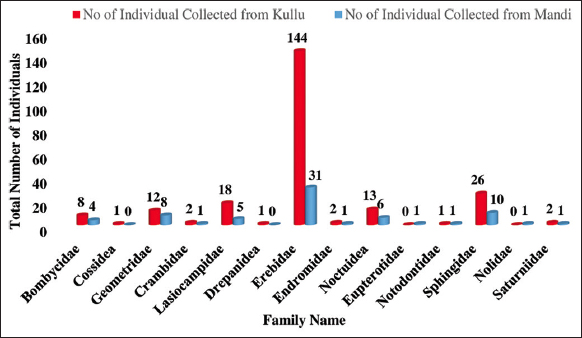 | Figure 3: Representation of total number of individuals collected from Mandi and Kullu District of Himachal Pradesh, India [Click here to view] |
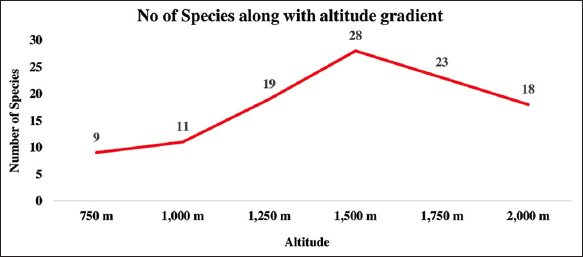 | Figure 4: Representation of total number of species collected from different altitude from Mandi and Kullu District of Himachal Pradesh, India [Click here to view] |
Table 4: List of all 23 new records of the moth species that have been 1st time recorded from Kullu district of Himachal Pradesh.
| S. No | Family | Subfamily | Scientific Name and Author | Gender (♂=Male ♀=Female) | Total samples collected | |
|---|---|---|---|---|---|---|
| 1 | Bombycidae | Bombycinae | Bombyx mandrina (Moore, 1872) | 1♂ | 1 | |
| 2 | Erebidae | Arctiinae | Cernyia arizana (Matsumura, 1927) | 1♂ | 1 | |
| 3 | Erebidae | Arctiinae | Cyana arorai | 1♂ | 1 | |
| 4 | Erebidae | Arctiinae | Cyana catorhoda (Hampson, 1897) | 1♀ | 1 | |
| 5 | Erebidae | Arctiinae | Lemyra boghaika (Tshistjakov and Kishida, 1994) | 1♂ | 1♀ | 2 |
| 6 | Erebidae | Arctiinae | Lemyra wernerthomasi (Inoue, 1993) | 2♂ | 2♀ | 4 |
| 7 | Erebidae | Arctiinae | Spilosoma pellucida (Rothschild, 1910) | 3♂ | 2♀ | 5 |
| 8 | Erebidae | Arctiinae | Spilosoma rhodophila (Walker, 1864) | 3♀ | 3 | |
| 9 | Erebidae | Catocalinae | Catocala palaeogama (Guenne, 1852) | 1♂ | 1 | |
| 10 | Erebidae | Herminiinae | Simplicia niphona (Butler, 1878) | 1♂ | 4♀ | 5 |
| 11 | Erebidae | Scoliopteryginae | Anomis mesogona (Walker, 1857) | 1♂ | 1 | |
| 12 | Erebidae | - | Bastilla amygdalis (Moore, 1885) | 1♂ | 1 | |
| 13 | Erebidae | - | Ericeia elongate (Prout, 1929) | 1♂ | 1 | |
| 14 | Erebidae | - | Sypna diversa (Wileman & South 1971) | 1♂ | 1 | |
| 15 | Lasiocampidae | - | Lebeda nobilis (Walker, 1855) | 1♂ | 2♀ | 3 |
| 16 | Noctuidea | Noctuinae | Atrovirensis taiwani (Gyulai, Ronkay and Wu, 2013) | 1♀ | 1 | |
| 17 | Noctuidea | - | Tiracola aureate (Holloway, 1989) | 4♂ | 4 | |
| 18 | Noctuidea | - | Tiracola grandirena (Herrich-Schaffer, 1868) | 1♂ | 1 | |
| 19 | Noctuidea | - | Tiracola plagiata (Walker, 1857) | 1♀ | 1 | |
| 20 | Noctuidea | - | Trichosea ludifica (Linnaeus, 1758) | 1♂ | 1 | |
| 21 | Notodontidae | Notodontinae | Cerura liturata (Walker, 1855) | 1♂ | 1 | |
| 22 | Saturniidae | Saturniinae | Caligula simla (Westwood, 1847) | 1♀ | 1 | |
| 23 | Sphingidae | Smerinthinae | Ambulyx lahora (Butler, 1875) | 1♀ | 1 | |
The most abundant species during the study was Nyctemera adversata (Schaller, 1788), which also belongs to the family Erebidae and subfamily Arctiinae (Arctiidae). The genitalia dissection of 54 moth’s samples was also performed. The moth’s population was found to be highest in the Kullu district, and the diversity of moths was highest in the months of July-September and declined from October onward. The photographs of all the identified species, along with their genitalia photograph are presented in Plates 1-9.
 | Plate 1: 1-2 (Bombycidae): 1(a) Bombyx huttoni (Westwood, 1847) ♂, 1(b) Bomhyx huttoni (Westwood, 1847) ♀, 2) Bomhyx Mandrina (Moore, 1872)♂, 3(Cossidea): 3) Zeuzera multistrigata (Moore, 1881)♂, 4 (Crambidae): 4(a) Pygospila tyres (Cramer, 1780) ♂, 4(b) Pygospila tyres (Cramer, 1780) ♀, 5 (Drepanidae): 5) Drepana pallida (Moore, 1879) ♂, 6 (Endromidae): 6(a) Mustilia sphingiformis (Moore, 1879) ♂, 6(b) Mustilia sphingiformis (Moore. 1879) ♀, 7-10 (Erebidae): 7(a) Asota caricae (Fabricius, 1775) ♂ 7(b) Asota caricae (Fabricius, 1775) ♀, 8(a) Aglaomorpha plagiata (Walker, 1855) ♂, 8(b) Aglaomorpha plagiata (Walker, 1855) ♀, 9) Areas galactina intermedia (Rothschild, 1933) ♂, 10) Areas galactina orientalis (Walker, 1855) ♂. [Click here to view] |
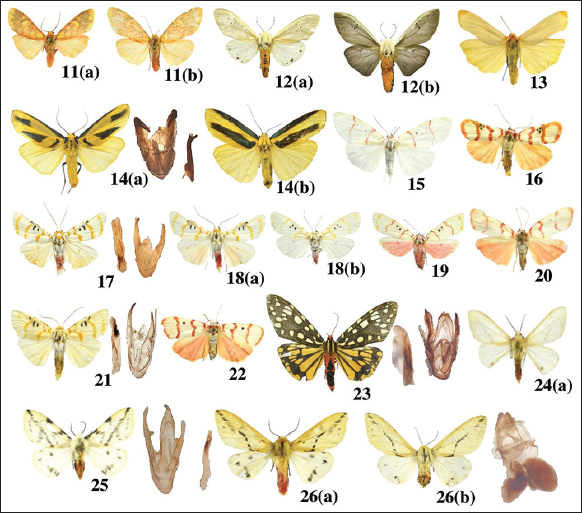 | Plate 2: 11-26 (Erebidae): 11(a) Barsine Sp. ♂, 11(b) Barsine Sp. ♀, 12(a) Ceratonotos transiens vacillans (Walker, 1855) ♂, 12(b) Ceratonotos transiens vacillans (Walker, 1855) ♀, 13) Cernyia arizanza (Matsumura, 1927) ♂, 14(a) Chrysorabdia bivitta (Walker, 1856) ♂, 14(b) Chrysorabdia bivitta (Walker, 1856) ♀, 15) Cyana adia (Moore, 1859) ♀, 16) Cyana arorai ♂, 17) Cyana arama arama (Moore, 1859) ♂, 18(a) Cyana arama metis ♂, 18(b) Cyana aeama metis ♀, 19) Cyana bellissima (Moore, 1878) ♀, 20) Cyana catorhoda (Hampson, 1897) ♀, 21) Cyana intercomma (Cerny, 2009) ♂, 22) Cyana peregrine (Walker, 1854) ♀, 23) Eucallimorpha principalis principalis (Kollor, 1844) ♂, 24(a) Lemyra boghaika (Tshistjakov and Kishida, 1994) ♂, 24(b) Lemyra boghaika (Tshistjakov and Kishida, 1994) ♀, 25) Lemyra multivittata (Moore, 1865) ♂, 26(a) Lemyra wernerthomasi (Inoue, 1993) ♂, 26(b) Lemyra wernerthomasi (Inoue, 1993) ♀,. [Click here to view] |
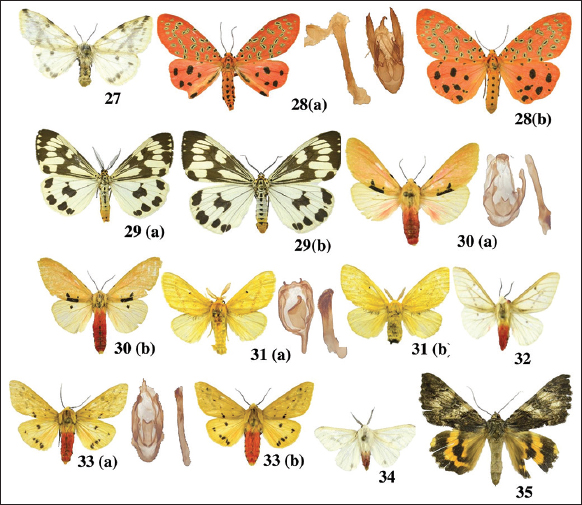 | Plate 3: 27-35 (Erebidae): 27) Lemyra Sp. ♂, 28(a) Mangina argus (Kollar, 1847) ♂, 28(b) Mangina argus (Kollar, 1847) ♀, 29(a) Nyctemera adversata (Schaller, 1788) ♂, 29(b) Nyctemera adversata (Schaller, 1788) ♀ 30(a) Spilarcria Sp. ♂, 30(b) Spilarcria Sp. ♀, 31(a) Spilosoma pellucida (Rothschild, 1910) ♂, 31(a) Spilosoma pellucida (Rothschild, 1910) ♀, 32) Spilosoma rhodophila (Walker, 1864) ♀, 33(a) Spilosoma sagittifera (Moore, 1888) ♂, 33(b) Spilosoma sagittifera (Moore, 1888) ♀, 34) Spilosoma Sp. ♀, 35) Catocala palaeogama (Guenne, 1852) ♂. [Click here to view] |
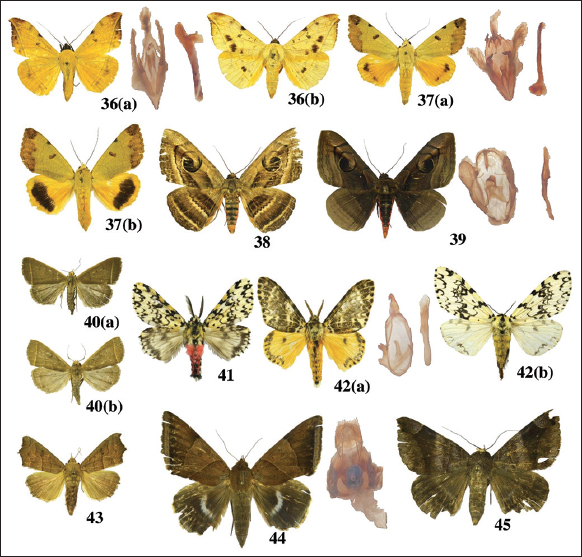 | Plate 4: 36-45 (Erebidae): 36(a) Hamodes propitia (Guerin-Meneville, 1831) ♂, 36(b) Hamodes propitia (Guerin-Meneville ♀, 1831), 37(a) Ophiusa tirhaca (Cramer, 1777) ♂, 37(b) Ophiusa tirhaca (Cramer, 1777) ♀, 38) Spirama helicina (Hubner, 1824) ♂ 39) Spirama retorta (Clerck, 1764) ♂, 40(a) Simplicia niphona (Butler, 1878), 40(b) Simplicia niphona (Butler, 1878) ♀, 41) Lymantria concolor concolor (Walker, 1855) ♂, 42(a) Lymantria Mathura subpallida (Moore, 1866) ♂,42(b) Lymantria Mathura subpallida (Moore, 1866) ♀ 43) Anomis mesogona (Walker, 1857) ♂, 44) Artena dotata (Fabricius, 1794) ♀, 45) Bastilla amygdalis (Moore, 1885) ♂. [Click here to view] |
 | Plate 5: 46-50 (Erebidae): 46) Ericeia elongate (Prout, 1929) ♂, 47) Mocis frugalis (Fabricius, 1775) ♂, 48(a) Bastilla arctotaenia (Gueene, 1852) ♂, 48(b) Bastilla arctotaenia (Gueene, 1852) ♀, 49) Sypna diversa (Wileman and South, 1971) ♂ 50) Sypna Sp. ♀, 51-55 (Geometridae): 51) Herochroma ochreipicta (C. Swinhoe, 1950) ♀, 52(a) Abraxas sylvata (Scopolia, 1763) ♂, 52(b) Abraxas sylvata (Scopolia, 1763) ♀, 53) Percnia belluaria (Guenee, 1858) ♂, 54) Iotaphore admirabilis (Oberthur, 1884) ♀ 55) Tanaorhinus reciprocatus confuciatis (Walker, 1861) ♀,. [Click here to view] |
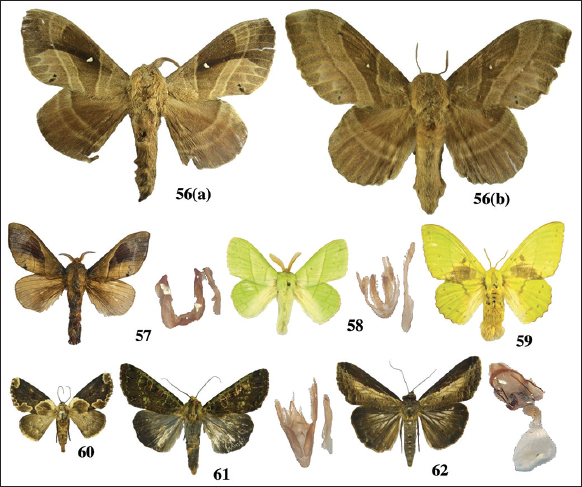 | Plate 6: 56-59 (Lasiocampidae): 56(a) Lebeda nobilis (Walker, 1855) ♂, 56(b) Lebeda nobilis (Walker, 1855) ♀, 57) Paralebeda Plagifera (Walker, 1855) ♂, 58) Trabala vishnou guttata (Mastrumura, 1909) ♂, 59) Trabala vishnou vishnou (Lefebver, 1827) ♀ 60-62 (Noctuidae): 60) Cymatophoropsis sinuate (Moore, 1879) ♀, 61) Atrovirensis taiwani (Gyulai, Ronkay and Wu, 2013) ♂ 62) Lophopera squammigera (Guenee, 1852) ♀. [Click here to view] |
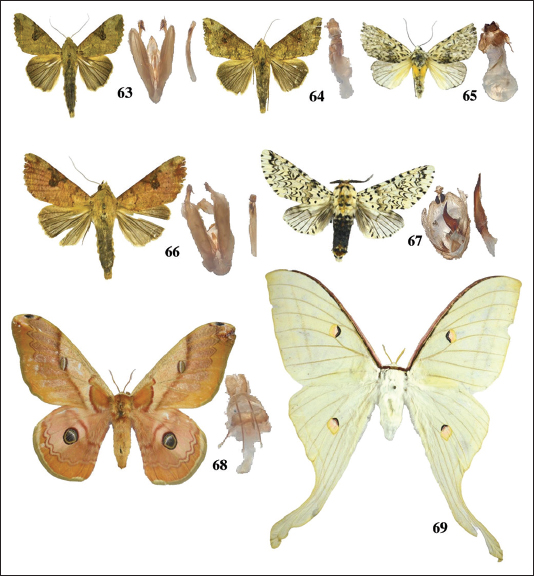 | Plate 7: 63-66 (Noctuidae): 63) Tiracola aureate (Holloway, 1989) ♂, 64) Tiracola grandirena (Herrich-Schaffer, 1868) ♀, 65) Trichosea ludifica (Lennaeus, 1758) ♀, 66) Tiracola plagiata (Walker, 1857) ♂ 67 (Notodontinae): 67) Cerura liturata (Walker, 1855) ♂, 68-69 (Saturniidae): 68) Caligula simla (Westwood, 1847) ♀, 69) Actias selene (Hubner, 1807) ♂. [Click here to view] |
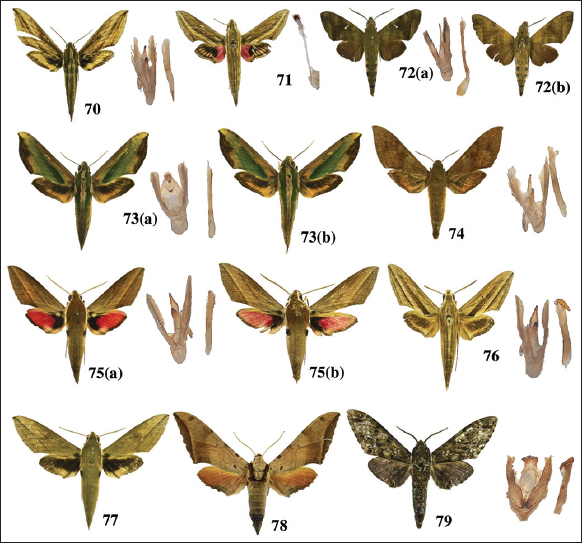 | Plate 8: 70-79 (Sphingidae): 70) Cechetra lineosa (Walker, 1856) ♂, 71) Hippotion celerio (Linnaeus, 1758) ♀, 72(a) Nephele hespera (Fabricius, 1775) ♂, 72(b) Nephele hespera (Fabricius, 1775) ♀, 73(a) Pergesa acteus (Cramer 1779) ♂,73(b) Pergesa acteus (Cramer 1779) ♀ 74) Rhagastis olivacea (Moore, 1872) ♂, 75(a) Theretra alecto (Linnaeus, 1758) ♂, 75(b) Theretra alecto (Linnaeus, 1758) ♀, 76) Theretra oldenlandiae (Fabricius, 1775) ♂, 77) Theretrs Sp. ♂ 78) Ambulyx lahora, (Butler 1875) ♀, 79) Dolbina sp. ♂. [Click here to view] |
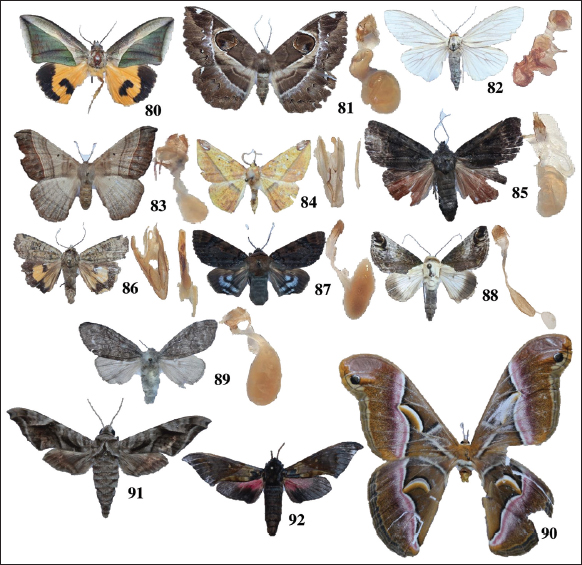 | Plate 9: 80-82 (Erebidae): 80 Eudocima salaminia (Cramer, 1777) ♀, 81 Erebus ephesperis (Hubner, 1827) ♀, 82 Himala argentea (Walker, 1855) ♀, 83 (Eupterotidae): Apona caschmirensia (Kollar, 1844) ♀, 84 (Geometridae): Pseudomiza aurata (Wileman, 1915) ♂, 85-87 (Noctuidae): 85 Amphipyra cupreipennis (Moore, 1882) ♀, 86 Xestia semiherbida (Walke, 1857) ♂, 87 Arcte coerula (Guenee, 1852) ♀, 88 (Nolidae): Risoba prominens (Moore, 1881) ♀, 89 (Notodontidae): Pheosia albivertex (Hampson, 1892) ♀, 90 (Saturniidae): Samia canningi (Hutton, 1859) ♀, 91-92 (Sphingidae): 91 Acosmeryx anceus subdentata (Rothschild and Jorean, 1903) ♂, 92 Anambulyx elwesi (H. Druce, 1882) ♂. [Click here to view] |
4. DISCUSSION
The studies on the species richness of Lepidoptera along the altitude gradient have been largely demonstrated by two major patterns. A linear decline in the richness with increasing altitude or a peak in richness at mid-elevation [19,29,38]. There could be many factors playing an important role in decreasing the species number above 1,500 m. According to the research conducted by Beck in 2010 [6], temperature could be one of the major factors because we know that moths are cold-blooded animals and they cannot maintain their body temperature by themselves, so they keep visiting the sunlight, and we know that at every 200 m increase in altitude from the main sea level, the temperature corresponds to an average drop of 1.5°C [58]. So, this could be one of the reasons for the sudden decrease in the species number above 1,500 m above the main sea level. Other reasons could be the plant assemblage structure (absence of the nectar plant, host plant, or alkaloid plant numbers in the region), moisture, habitat destruction, etc., which could be some of the major factors [6].
5. CONCLUSION
The study records 82 species of moths, and from the above, we concluded that Erebidae is the most dominant family in Kullu and Mandi districts of Himachal Pradesh. At low altitudes, i.e., 750 m above sea level, we were able to collect 9 species, and at an altitude of 1,000 m above main sea level, there was a small increase in the number of species, i.e., 11 species were collected, and at 1,250 m above sea level, the species collected was 19, and as the altitude keeps increasing, the species number also keeps increasing, i.e., at 1,500 m above main sea level, 28 species were collected. But this increasing species number with the increase in altitude was up to 1,500 m only, and as we kept increasing the altitude above the main sea level, the species number suddenly started decreasing, and we collected 23 species at 1,750 m above the main sea level. As we continued to ascend higher, the species number again decreased, and we collected 18 species at 2.000 m altitude above the main sea level. So, we conclude that, as we stated in our collection from the low altitude, the species number starts increasing up to 1,500 m altitude; above this altitude, the species number starts decreasing, also reported by Ashton research in 2013 [4].
6. ACKNOWLEDGEMENTS
We thank Dr. Avtar Kaur Sidhu (lepidopterist), Akhil Nair (lepidopterist), Zoological Survey of India (ZSI), Solan, for helping us identify the collected specimen and allowing us to compare our collected specimen with their already collected and identified specimens. We also would like to thank the reviewers for reading and offering their valuable suggestions and comments.
7. AUTHOR CONTRIBUTIONS
All authors made substantial contributions to conception and design, acquisition of data, or analysis and interpretation of data; took part in drafting the article or revising it critically for important intellectual content; agreed to submit to the current journal; gave final approval of the version to be published; and agreed to be accountable for all aspects of the work. All the authors are eligible to be authors as per the International Committee of Medical Journal Editors (ICMJE) requirements and guidelines.
8. FUNDING
This research did not receive any specific grants from funding agencies in the public, commercial, or not-for-profit sectors.
9. CONFLICT OF INTEREST
The authors have no conflicts of interest to declare that are relevant to the content of this article.
10. ETHICAL APPROVALS
The ethical approval is not applicable for this type of study.
11. DATA AVAILABILITY
The moth samples are preserved in the insect storage box at Zoology lab at Shoolini University, upon request, the data used to support the finding are provided The databases contain details about the species identification, family name, genus name, species name, collecting locations, times, and any related metadata that is pertinent to the study of moth populations. Researchers are urged to get in touch with the corresponding author if they are interested in obtaining the data for validation, replication, or additional research. Subject to any applicable privacy, legal, or ethical restrictions, access to the data shall be granted as soon as possible.
12. USE OF ARTIFICIAL INTELLIGENCE (AI)-ASSISTED TECHNOLOGY
All claims expressed in this article are solely those of the authors and do not necessarily represent those of the publisher, the editors and the reviewers. This journal remains neutral with regard to jurisdictional claims in published institutional affiliation.
13. PUBLISHER’S NOTE
This journal remains neutral with regard to jurisdictional claims in published institutional affiliations.
REFERENCES
1. Alfred JR, Das AK, Sanyal AK. Faunal Diversity in India. Kolkata:ENVIS Centre, Zoological Survey of India;1998. 311-8.
2. Allen MG. Marvellous Moths of Nepal. Know Nepal Series Number 6. Kathmandu, Nepal:Rohit Kumar;1993. 72.
3. Arjun GS. Taxonomic Study of Moths Lepidoptera Heterocera from North Maharashtra India. Pune:Savitribai Phule Pune University;2013.
4. Ashton LA. Moths and Mountains Diversity, Altitude, and Latitude (Doctoral Dissertation, PhD Thesis. Brisbane Griffith University;2013.
5. Barlow HS. An Introduction to the Moths of South East Asia. Kuala Lumpur, Malaysia:Malayan Nature Society 2029;1982.
6. Beck J, Altermatt F, Hagmann R, Lang S. Seasonality in the altitude-diversity pattern of Alpine moths. Basic Appl Ecol 2010;11:714-22. [CrossRef]
7. Beeson CF. The Ecology and Control of Forest Insects of India and the Neighbouring Countries. Part 1. India:Government of India;1941. 767.
8. Bell TR, Scott FB. The Fauna of British India, Including Ceylon and Burma. Moths. Sphingidae. Vol. 5. London:Taylor and Francis;1937. 537pp+15pls.
9. Benton TG. Biodiversity and biogeography of Henderson Island's insects. Biol J Linn Soc 1995;56:245-59. [CrossRef]
10. Chandra K, Nema DK. Moths of Pench tiger reserve (Seoni, Madhya Pradesh). J Trop Forest 2003, 2011;19:68-78.
11. Chandra K, Kumar V, Singh N, Raha A, Sanyal AK. Assemblages of Lepidoptera in Indian Himalaya through Long Term Monitoring Plots. Kolkata:Published by the Director, West Bengal Zoological Survey of India;2019. 1-45.
12. Chandra K, Nema DK. Fauna of Madhya Pradesh (Including Chhattisgarh) Part-I, State Fauna Series-15. Kolkata:Zoological Survey of India;2007. 1-347.
13. Chapman RF. The Insects Structure and Function. 4th ed. Cambridge:University Press;1998. 45.
14. Das GN, Gayen S, Ali M, Jaiswal RK, Lenin EA and Chandra K. Insecta Lepidoptera (Butterflies). In:Chandra K, Gupta D, Gopi KC, Tripathy B, Kumar V, editors. Faunal Diversity of Indian Himalaya. Kolkata, India:Zoological Survey of India;2018a. 611-50.
15. Evans WH. Identification of Indian Butterflies. 2nd ed. Mumbai:Bombay Natural History Society;1932. 1-35.
16. Fatimah A, Catherine AK. The Larger Moths (Lepidoptera Heterocera) of the Crocker Range National Park, Sabah A preliminary checklist. In:ASEAN Review of Biodiversity and Environmental Conservation. Vol. 18. Malaysia;2002. 1-14.
17. Friedrich E. Breeding Butterflies and Moths a Practical Handbook for British and European Species. Colchester, England:Harley Books;1986. 176. [CrossRef]
18. Gerard PJ. The digestive system of the keratin-feeding larvae of Hofmannophila pseudospretella (Lepidoptera Oecophoridae). N Z J Zool 2002;29:15-22. [CrossRef]
19. Hagvar S. Altitudinal zonation of the invertebrate fauna on branches of birch (Betula pubescens Ehrh.). Norwegian J Entomol 1976;23:61-75.
20. Hampson G. The Fauna of British India, Including Ceylon and Burma. Moths. Saturniidae to Hypsidae. Vol. 1. London:Taylor and Francis;1892. 527pp+333figs.
21. Hampson G. The Fauna of British India, Including Ceylon and Burma. Moths-Arctiidae, Agrostidae, Noctuidae. Vol. 2. London:Taylor and Francis;1894. P. 609pp+325figs.
22. Hampson G. The Fauna of British India, Including Ceylon and Burma. Moths. Noctuidae (cont.) to Geometridae.Vol. 3. London:Taylor and Francis;1895. 546pp+226figs.
23. Haruta T, editor. Moths of Nepal, Part 1, Tinea. 13 (Suppliment 2). Tokyo:Japan Heteerocerists Society;1992. 122pp+109fig+32pls.
24. Haruta T, editor. Moths of Nepal, Part 2, Tinea. 13 (Suppliment 2). Tokyo:Japan Heteerocerists Society;1993. 160pp+221fig+32pls.
25. Haruta T, editor. Moths of Nepal, Part 3, Tinea. 14 (Supplement 1). Tokyo:Japan Heterocerists'Society;1994. 171pp+206figs+32pls.
26. Haruta T, editor. Moths of Nepal, Part 4, Tinea. 14 (Supplement 2). Tokyo:Japan Heterocerists'Society;1995. 206pp+303figs+32pls
27. Haruta T, editor. Moths of Nepal, Part 5, Tinea. 15 (Supplement 1). Tokyo:Japan Heterocerists'Society;1998. 330pp+403figs+32pls.
28. Haruta T, editor. Moths of Nepal, Part 6, Tinea. 16 (Suppl 1). Tokyo:Japan Heterocerists'Society;2000. 163pp+273figs+14pls.
29. Hebert PD. Moth communities in Montane Papua New Guinea. J Anim Ecol 1980;49:593-602. [CrossRef]
30. Holloway JD. The moths of Borneo. Part 4, Family Notodontidae. Kuala Lumpur:Malayan Nature Society and Southdene;1983. 371-107.
31. Holloway JD. The moths of Borneo. Part 14, Family Noctuidae Subfamilies Euteliinae, Stictopterinae, Plusiinae, Pantheinae. Malayan Nat J 1985;38:157-317.
32. Holloway JD. The moths of Borneo. Part 1, Key to families;Cossidae, Metarbelidae, Ratardidae, Dudgeoneidae, Epipyropidae and Limacodidae. Malayan Nat J 1986;4:1-165.
33. Holloway JD. The Moths of Borneo Part 3, Families Lasiocampidae, Eupterotidae, Bombycidae, Brahmaeidae, Saturniidae, Sphingidae. Kuala Lumpur, Malaysia:Southdene Sdn. Bhd.;1987. 199pp+163figs+20pls.
34. Holloway JD. The Moths of Borneo Part 6, Family Arctiidae Subfamilies Arctiinae, Syntominae, Aganainae (to Noctuidae). Kuala Lumpur, Malaysia:Southdene Sdn Bhd.;1988. 101pp+168fig+6pls.
35. Holloway JD. The moths of Borneo Part 9, Family Geometridae Subfamilies Oenochrominae, Desmobathrinae, Geometrinae. Malayan Nat J 1996;49:147-326.
36. Holloway JD. The moths of Borneo Part 12, Family Noctuidae Subfamilies Noctuinae, Heliothinae, Hadeninae, Acronictinae, Amphipyrinae, Agaristinae. Malayan Nat J 1989;4:357-226.
37. Inoue H, Kennett RD, Kitching IJ. Moths of Thailand. Sphingidae. Vol. 2. Bangkok:ChokChai Press;1996. 149pp+44pls.
38. Janzen DH, Ataroff M, Farinas M, Reyes S, Rincon N, Soler A, et al. Changes in the arthropod community along an elevational transect in the Venezuelan Andes. Biotropica 1976;8:193-2. [CrossRef]
39. Kato M. A monograph of epipyropidae (Lepidoptera). Entomol World 1940;8:67-94.
40. Kendrick RC. Moths (Insecta Lepidoptera) of Hong Kong. PhD Thesis. Vol. 47. Hong Kong:University of Hong Kong;2002. 1660.
41. Montgomery SL. Biogeography of the moth genus Eupithecia in Oceania and the evolution of ambush predation in Hawaiian caterpillars (Lepidoptera Geometridae). Entomol Generalis 1982;8:27-34. [CrossRef]
42. Moore F. List of the Lepidoptera Collected by Rev. J.H. Hocking chiefly in the Kangra Dist., N.W. Himalaya with Description of New Genera and Species. In:Proceedings of the Zoological Society of London;1882. 234-263 [CrossRef]
43. Van Nieukerken EJ, Kaila L, Kitching IJ, Kristensen NP, Lees DC, Minet J, et al. Order Lepidoptera Linnaeus, 1758. In:Zhang, Z.-Q. (Ed.), Animal biodiversity An outline of higher-level classification and survey of taxonomic richness. Zootaxa 2011;3148:212-21. [CrossRef]
44. Van Nieukerken EJ, Kaila L, Kitching IJ, Kristensen NP, Lees DC, Minet J, et al. Order Lepidoptera Linnaeus, 1758. In:Zhang, Z.-Q. (Ed.), Animal biodiversity An outline of higher-level classification and survey of taxonomic richness. Zootaxa 2011;3148:212-21. [CrossRef]
45. Rewatkar VK. India as mega biodiversity nation:A fantastic “ethnobotanical museum”;2020:1-6.
46. Richards DW. Imm's General Textbook of Entomology. Classification and Biology. 10th ed., Vol. 2. New Delhi:B. I. Publications;1977. 1072-161. [CrossRef]
47. Robinson GS, Tuck KR, Shaffer M, Cook K. The smaller moths of South-East Asia. Kuala Lumpur:Malaysian Nature Society;1994. 308pp+51figs+32pls.
48. Robinson GS, Ackery PR, Kitching IJ, Beccaloni GW, Hernandez LM. Hostplants of the moth and butterfly caterpillars of the oriental region. London:Natural History Museum;2001. 722.
49. Robinson GS. Clothes-Moths and Keratin in Asian rainforest. In Knight WJ, Holloway JD, editor. Insects and the Rain Forests of South East Asia (Wallacea). London:Royal Entomological Society;1990. 305-8.
50. Rohlf FJ. TpsDig, Version 1.40. Department of Ecology and Evolution. New York:State University of New York at Stony Brook;2004a.
51. Gurule SA, Nikam SM. The moths (Lepidoptera Heterocera) of Northern Maharashtra A preliminary checklist. J Threatened Taxa 2013;5:4693-713. [CrossRef]
52. Sanyal AK, Mallick K, Khan S, Bandyopadhyay U, Mazumder A, Bhattacharyya K, et al. Insecta Lepidoptera (Moths). In:Chandra K, Gupta D, Gopi KC, Tripathy B, Kumar V, editors. Faunal Diversity of Indian Himalaya. Kolkata, India:Zoological Survey India;2018. 872, 651-726.
53. Scott FB. Notes on Indian Hawkmoths, a century of natural history. J Bombay Nat History Soc 1983;1:618-31.
54. Sharma G, Ramamurthy VV. A Checklist of Lepidopterous Pests of Vegetables in India. New Delhi, Pusa:Zoological Survey of India and Indian Agricultural Research Institute;2010. 1-14. Available from https//zsi.gov.in/checklist/gaurav-checklist
55. Sidhu AK. Lepidoptera of India A review. J Entomol Zool Stud 2023;11:105-14. [CrossRef]
56. Sivasankaran K, Gnanasekaran S, Paradhaman D, Ignacimuthu S. Diversity of Noctuid moths (Lepidoptera, noctuidae) in Tamil Nadu part of Western Ghats (Nilgiri Biosphere and Kodaikanal hills). India. Elixir Bio Divers 2011;38:4131-4.
57. Srivastava A. Taxonomy of Moths in India. Dehradun, India:Published by International Book Distributors;2002. 1-334.
58. Strong CL, Boulter SL, Laidlaw MJ, Putland D, Kitching RL. The physical environment of an altitudinal gradient in the rainforest of Lamington National Park, Southeast Queensland. In Memoirs of the Queensland Museum. Wyoming US:Creative Media Partners, LLC;2011.
59. Zborowski P, Edwards T. A Guide to Australian Moths. Australia:CSIRO Publishing;2007. p. 224. [CrossRef]